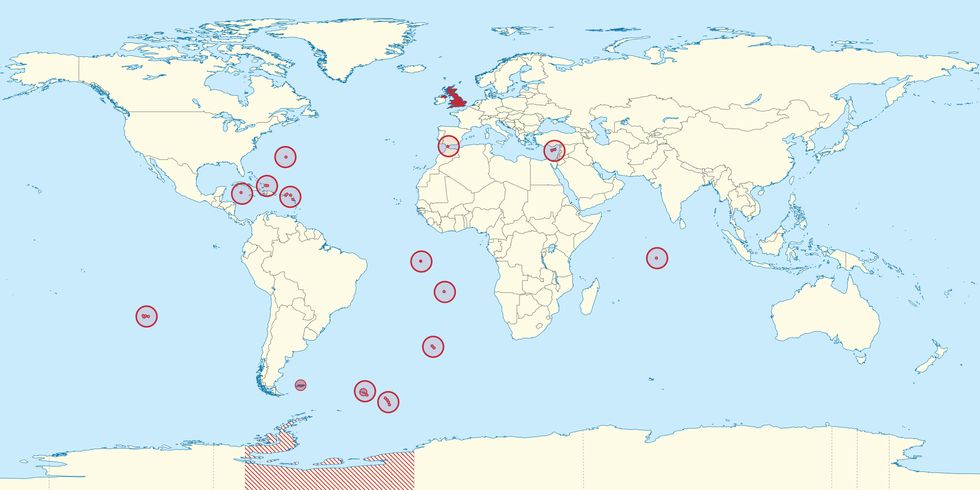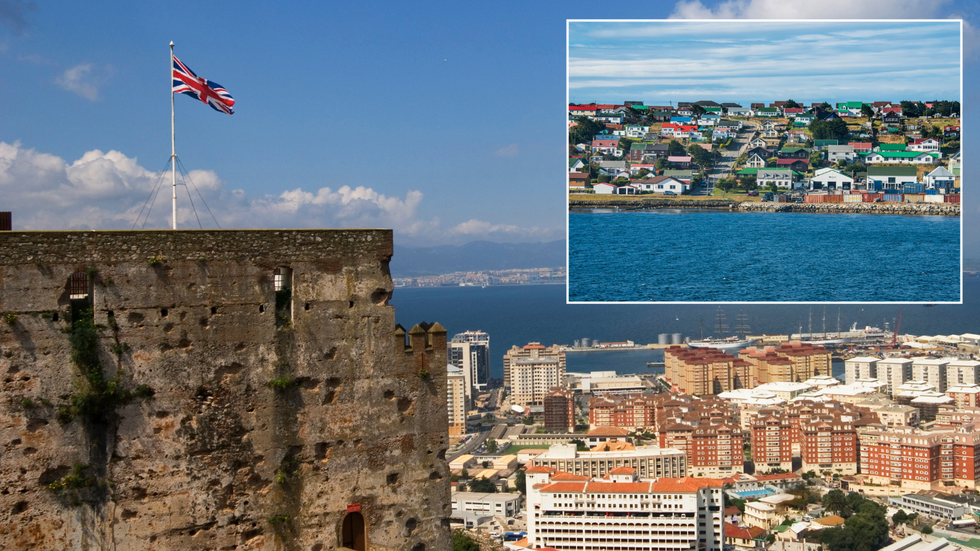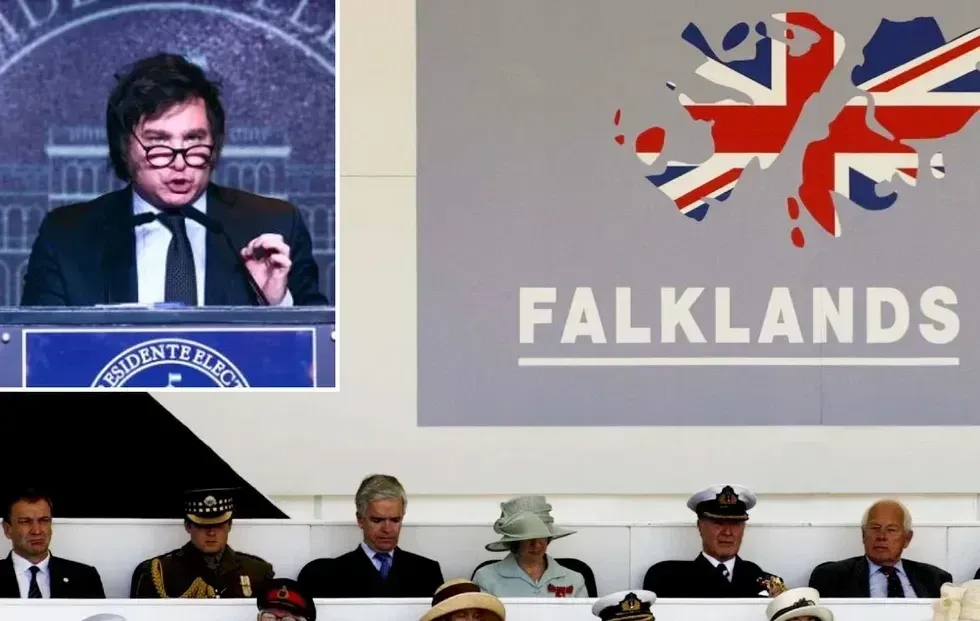Where next?! Map reveals vital British territories Starmer could surrender next as Chagos saga intensifies
A terrifying map of Britain’s vital overseas territories has emerged showing what Starmer and Lammy could give away next in a ‘Chagos style’ surrender currently being finalised.
Labour’s handover of the island group, reported to cost £9billion, has drawn fierce criticism as an expensive strategic blunder that will allow China to expand its influence in the Indian Ocean.
It has been dominating headlines after reports Labour is trying to ram through the deal before Trump takes office and vetoes the handover.
With an announcement imminent, a map has emerged showing Britain’s other vital overseas territories that commentators are fearing Starmer and his Foreign Secretary David Lammy could give away next.

From Falklands to Gibraltar, the map highlights how strategically important Britain’s overseas territories are, allowing the nation to project military power in far flung corners of the globe.
With major RAF bases on many of the territories, commentators have likened them to ‘unsinkable aircraft carriers’, allowing the UK and its NATO allies to police trade routes and deter aggression.
Geopolitics experts also highlight the soft power the territories give Britain. Many have varying forms of self-governance, meaning their representatives often side with Britain in International Organisations like the UN.
Despite being many thousands of miles from Britain, the territories also promote British values and customs like freedom of speech.
This goes without mentioning valuable access to natural resources, fishing rights, tourism benefits and financial hubs.
There are also strong cultural and historical ties between Britain and its territories, with much of their respective populations wanting to be a part of Britain.
Starmer argues that so long as the military base is protected, the handover will not affect the UK’s foreign interests.
Labour also points to international pressure to handover the islands, with many viewing the UK’s control as an imperial hangover which should be corrected.
LIST OF OVERSEAS TERRITORIES LABOUR COULD SURRENDER
Akrotiri and Dhekelia, Cyprus, Mediterranean Sea.
Size: 255 km2 (98 sq mi)
Population: 7,700 (Cypriots; estimate) 8,000 non-permanent (UK military personnel and their families; estimate).
GDP: n/a
This vitally important territory is key to the UK’s surveillance and intelligence gathering operations in the Middle East, including the Suez Canal.
Home to a major RAF outpost, it allows the UK to protect its assets in the Mediterranean, policing vital trade routes through which much of the UK’s oil imports travels.
The base is whole heartedly claimed by Cyprus whose government is adamant the UK should surrender its sovereignty.
Gibraltar, Iberian Peninsula, Continental Europe
Size: 6.5 km² (2.5 sq mi)
Population: 33,701 (2019 estimate), 1,250 non-permanent (UK military personnel; 2012 estimate)
GDP: $3.08 billion
Gibraltar is a strategic naval and trade hub at the entrance to the Mediterranean, providing the UK with oversight over one of the world’s most significant shipping lanes.
The territory serves as a vital base for intelligence gathering operations in Africa.
Spain persistently claims sovereignty over Gibraltar, leading to ongoing diplomatic tensions.
British Antarctic Territory, Antarctica
Size: 1,709,400 km² (660,000 sq mi)
Population: 0 (50 non-permanent in winter, over 400 in summer)
GDP: N/A
This territory is essential for scientific research, particularly in climate change and glaciology.
It reinforces the UK’s role in international Antarctic treaties. However, Argentina and Chile challenge the UK’s claims under the Antarctic Treaty System.

Falkland Islands, South Atlantic Ocean
Size: 12,173 km² (4,700 sq mi)
Population: 3,377 (2019 estimate), 1,350 non-permanent (UK military personnel)
GDP: $164.5 million
The Falklands are vital for UK defence strategy in the South Atlantic, with significant oil reserves bolstering economic potential.
The islands are central to British geopolitical influence in the region. Argentina, who invaded the Islands in 1982, continues to claim sovereignty, stoking tensions in the region.
British Indian Ocean Territory, Indian Ocean
Size: 60 km² (23 sq mi)
Population: 0 (3,000 non-permanent UK and US military personnel and staff)
GDP: N/A
This strategically located territory houses the critical Diego Garcia military base, supporting UK and US operations in the Indian Ocean and Middle East.
It secures vital maritime trade routes and intelligence capabilities. Mauritius disputes the UK’s sovereignty, and an agreement to transfer control is under negotiation.
South Georgia and the South Sandwich Islands, South Atlantic Ocean
Size: 3,903 km² (1,507 sq mi)
Population: 0 permanent, 99 non-permanent (officials and research personnel)
GDP: N/A
This territory is significant for scientific research, fisheries, and environmental conservation.
Its location enhances the UK’s strategic control in the South Atlantic.
Argentina disputes sovereignty over the islands, which were occupied during the Falklands War.
LATEST FROM MEMBERSHIP:
- SHOCK model shows Reform snatching 81 seats in Labour bloodbath – full seat breakdown REVEALED
- I always thought I was blinded by headlights because I’m older but that’s not true – Nigel Nelson
- WATCH: Wales Labour leader SNUBS call for grooming gangs inquiry THREE times – ‘national disgrace!’

Conflicting reports are currently emerging from the Chagos Islands, with some claiming Britain may wait for Trump’s term to begin.
Much of the haggling has been over the military base of Diego Garcia which hosts US and UK forces.
The UK and US want to continue leasing the base for 99 years, but the Mauritians are demanding that comes down to 50 years after which they will charge £90million a year to host the base.
GB News Chris Hope reports this morning that a deal has not been reached and negotiations will continue into next week, meaning Trump will have returned and can veto the plans.
TERRITORIES NOT UNDER IMMEDIATE THREAT
Anguilla, Caribbean, North Atlantic Ocean
Size: 91 km² (35.1 sq mi)
Population: 14,869 (2019 estimate)
GDP: $299 million
Anguilla is a strategic asset for the UK in the Caribbean, promoting economic stability through tourism and financial services.
The territory has no significant sovereignty disputes.
Bermuda, North Atlantic Ocean
Size: 54 km² (20.8 sq mi)
Population: 62,506 (2019 estimate)
GDP: $6.464 billion
Bermuda is a global financial hub, contributing significantly to the UK’s international trade and insurance sectors.
Its location makes it a vital stopover for transatlantic shipping and air routes. Bermuda has no external sovereignty disputes.
British Virgin Islands, Caribbean, North Atlantic Ocean
Size: 153 km² (59 sq mi)
Population: 31,758 (2018 census)
GDP: $1.05 billion
This territory is a significant offshore financial centre and tourism destination, vital for UK-Caribbean economic relations.
Its stability supports regional trade and investment. There are no substantial disputes over its governance.
Cayman Islands, Caribbean
Size: 264 km² (101.9 sq mi)
Population: 78,554 (2022 report)
GDP: $4.298 billion
As a leading financial centre, the Cayman Islands play a pivotal role in global banking and investments.
Its robust tourism industry also supports UK economic interests in the region. The territory is self-governing, with no external sovereignty disputes.
Montserrat, Caribbean, North Atlantic Ocean
Size: 101 km² (39 sq mi)
Population: 5,215 (2019 census)
GDP: $61 million
Montserrat is a cultural and economic bridge between the UK and the Caribbean, offering rich natural resources and tourism potential.
Despite being heavily impacted by volcanic activity, the UK has invested in rebuilding and maintaining the island. There are no external sovereignty disputes over Montserrat.
Pitcairn Islands, Pacific Ocean
Size: 47 km² (18 sq mi)
Population: 35 (2023 estimate), 6 non-permanent (2014 estimate)
GDP: $144,715
As the UK’s only territory in the Pacific, the Pitcairn Islands play a role in maintaining the UK’s maritime presence in this vast region.
Its isolation makes it a unique environmental conservation area and a symbol of British sovereignty. The islands have no sovereignty disputes.
Saint Helena, Ascension, and Tristan da Cunha, South Atlantic Ocean
Size: 420 km² (162 sq mi)
Population: 5,633 (2016 census)
GDP: $55.7 million
These islands are critical for UK naval and air operations in the South Atlantic, with Saint Helena also offering historical and tourism value.
Tristan da Cunha is one of the most remote inhabited archipelagos, contributing to marine conservation.
The islands face no external sovereignty disputes.
Turks and Caicos Islands, Caribbean
Size: 948 km² (366 sq mi)
Population: 38,191 (2019 estimate)
GDP: $1.077 billion
Turks and Caicos is a major tourism and financial hub, bolstering the UK’s economic ties with the Caribbean.
The islands serve as a stable regional partner for trade and investment. There are no significant sovereignty disputes over this territory.

